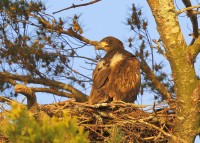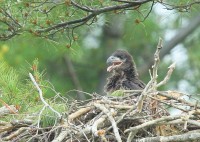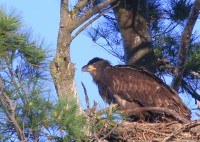Bald Eagle nest: Plymouth County
June 15, 2017 in Bald Eagle
 Had a nice visit by kayak to a Bald Eagle nest in Plymouth County with a pair of eaglets. In terms of size and shape they appear to be close to fledging time. The other eaglet was resting and almost out of sight in the nest. The adult female was perched not far away on a tree snag. Here’s a quick recap of the timeline for growth in an eagle chick:
Had a nice visit by kayak to a Bald Eagle nest in Plymouth County with a pair of eaglets. In terms of size and shape they appear to be close to fledging time. The other eaglet was resting and almost out of sight in the nest. The adult female was perched not far away on a tree snag. Here’s a quick recap of the timeline for growth in an eagle chick:
The young birds grow rapidly, they add one pound to their body weight every four or five days. At about two weeks, it is possible for them to hold their head up for feeding. By three weeks they are 1 foot high and their feet and beaks are very nearly adult size. Between four and five weeks, the birds are able to stand, at which time they can began tearing up their own food. At six weeks, the eaglets are very nearly as large as their parents. At eight weeks, the appetites of the young birds are at their greatest. While parents hunt almost continuous to feed them, back at the nest the eaglets are beginning to stretch their wings in response to gusts of wind and may even be lifted off their feet for short periods.
This pair of eaglets are in wing stretching mode and ready for flight very soon!


